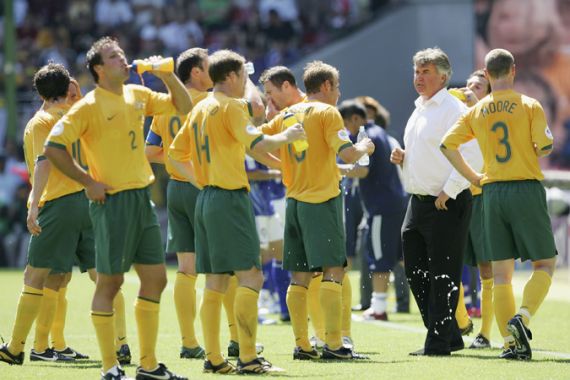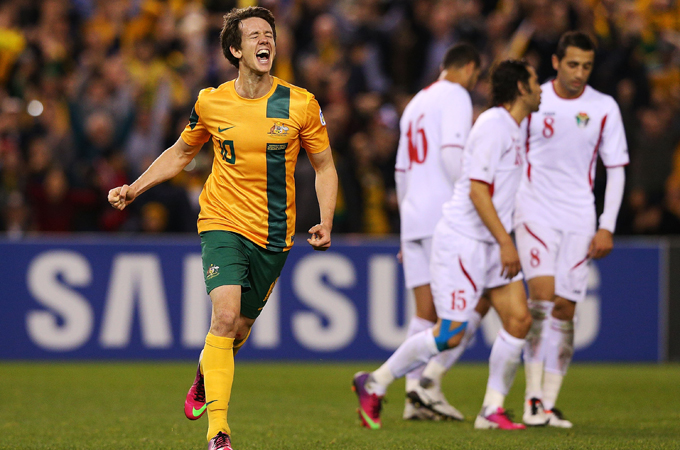‘In Guus we trust’
Is a reunion with former head coach Guus Hiddink a wise move ahead of 2014 World Cup campaign?

It is never wise, they say, to go back to an old flame. So, is the Australian football fraternity courting disaster by contemplating a reunion with former head coach Guus Hiddink ahead of the 2014 FIFA World Cup?
This week, Hiddink’s agent Cees van Nieuwenhuizen confirmed that the currently unattached Dutchman would be open to an approach from Football Federation Australia (FFA).
Keep reading
list of 4 items‘Disgrace’: Ten Hag slams criticism over Man United’s FA Cup semifinal win
Inter win heated Milan derby to seal 20th Siere A title
Bellingham’s late El Clasico winner leaves Madrid with one hand on La Liga
Hiddink remains a much-loved figure in Australia after guiding the Socceroos to their best-ever World Cup finish at Germany in 2006 where they made the knockout stages before losing 1-0 to eventual champions, Italy after a disputed, last-minute penalty.
“In Guus We Trust” became the fans’ mantra as the Socceroos emerged from a group of death containing Brazil, Croatia and Japan, driven by Hiddink’s bold tactics. His face even ended up on an Australian postage stamp.
Of course, there is no official word that FFA will part ways with their current manager, Holger Osieck. But the German is reportedly on shaky ground after the Socceroos were thrashed 6-0 by World Cup hosts Brazil in last weekend’s friendly in Brasilia.
During the 2006 World Cup, Australia faced a much stronger Brazil team in Munich. Yet they held the Selecao scoreless in the first half before losing 2-0, the second goal coming on the break in the 90th minute as the Socceroos pushed for an equaliser.
Osieck will argue that the team of seven years ago was far more adept than today’s crop. At the 2006 World Cup, more than half of the squad played in the three top leagues of Europe. The 2014 selection could have just two players from the English Premier League and perhaps only one from the Bundesliga.
Dad’s Army
But seven years after the highs of Germany, Osieck is still clinging on to the nation’s so-called Golden Generation, very much Dad’s Army, as the Great Southern Land marches hesitantly – and very slowly – towards Brazil. Amazingly, as many as ten of the 2006 squad could be picked again for the 2014 tournament.
Captain Lucas Neill turns 36 three months before the tournament begins next June and goalkeeper Mark Schwarzer will be almost 42. Harry Kewell will be 35 while Tim Cahill and Mark Bresciano will be 34. Even Mark Milligan, who was the baby of the 2006 squad, turns 29 just three weeks after the 2014 final.
Part of the problem is that the new crop of players hasn’t blossomed in the way that many people hoped they would.
Midfielder Brett Holman, touted as the next Aussie star of the English Premier League, jumped ship at Aston Villa after one unfulfilled season and headed for the riches of Al Nasr in the UAE Arabian Gulf League.
 |
| Rising star of the Australian squad, Robbie Kruse [GETTY] |
Striker Scott McDonald, the 2007-2008 top-scorer in the Scottish Premier League and regular for Celtic in the UEFA Champions League, is now languishing in England’s second tier with struggling Millwall and has never found the net at senior national level. Winger Nathan Burns, once dubbed the new Harry Kewell, is back in the A-League after frustrating spells in Greece and Korea.
The brightest hopes are Bayer Leverkusen striker Robbie Kruse, Celtic midfielder Tom Rogic and FC Utrecht winger Tommy Oar, yet Kruse and Rogic are often warming the benches of their respective clubs.
Initially, Osieck made an impressive improvement, taking Australia to the final of the 2011 AFC Asian Cup. He freshened up the Socceroos’ 2010 World Cup squad by injecting newcomers like Sasa Ognenovski, Matt McKay and Mile Jedinak. The passing and movement were crisp and a 6-0 semi-final demolition of Uzbekistan proved what was possible when the team clicked.
But the 2014 World Cup qualifying campaign was often turgid, with defeats to Oman and Jordan and some unconvincing victories. Passage to Brazil was only secured on their final matchday when Josh Kennedy’s late header gave Australia a 1-0 home victory over an Iraq side, packed with inexperienced teenagers tuning up for the FIFA Under-20 World Cup.
Quick fix
Some might argue that Hiddink’s appointment would be only a short-term solution. But that is exactly what the Socceroos’ need, with the 2014 World Cup followed by the 2015 AFC Asian Cup on Aussie soil from January 9th.
Worryingly, Lucas Neill has already been appointed Captain Ambassador for the Asian Cup, which hints at the central defender’s continuing on-field involvement. A fine servant of the game, Neill has played just a handful of club matches over the past two years and recently signed a short-term deal with Omiya Ardija in the J-League as he scrambles for game-time.
At the 2010 World Cup where Australia gave a respectable performance despite conceding two red cards (1 win, 1 draw, 1 loss), Neill was already approaching the twilight of his career. If you remove his leadership credentials, there is no way that a struggling Neill should be trying to contain the likes of Neymar, Mario Balotelli and Lionel Messi.
But it is highly unlikely that Osieck would dare contemplate leaving out the 82-cap veteran, who is aiming for his third straight appearance at the FIFA showcase.
The beauty of Hiddink’s management style is its brutal honesty. This is the man who walked into the Australian set-up in 2005 after the chaos of the Frank Farina reign and made some very harsh decisions.
He dumped 2004 Olympics’ captain Ljobo Milicevic from the squad. He refused to play veterans Stan Lazaridis and Josip Skoko at Germany ’06, even though both were with English Premier League clubs. He got phenomenal performances out of Brett Emerton, Scott Chipperfield and Vince Grella after a boot camp-like pre-tournament training camp. And he unearthed unlikely gems like Luke Wilshire whom he plucked from third-tier Bristol City.
During a famous interview with Dutch TV during the tournament, Hiddink compared the Socceroos to a lower league team in the Netherlands in terms of their technical ability – but with an unbelievably big heart. One might argue that the heart remains, but without the self-belief and structure.
Since parting ways with the Socceroos in July 2006, Hiddink has had mixed success as national coach of both Turkey and Russia and as club manager for Chelsea (caretaker) and Anzhi Makhachkala.
He’s egotistical, eccentric and very expensive – but he could be just the tonic that the Socceroos need. Given his reputation Down Under, you would immediately sense a different vibe in the dressing room. And he’d be tough enough to tap a few oldies on the shoulder and quickly show them the door.
As former Socceroo Jason Culina, who played for Hiddink at PSV Eindhoven so eloquently put it: “What would be better: going to the World Cup with a young experimental team, building for the future and losing every game 3-0 – or going with the older established team and losing by the same margins?”
Former Argentina and Chile coach Marcelo Bielsa has been touted as another possible replacement for Osieck, but his lack of English speaking skills might limit his impact in a short-term role.
Given their current predicament, there is not much downside if Australia put Guus the Great in charge. If nothing else, he will refuse to play favourites and put on-field performances above everything else.
Jason Dasey (www.jasondasey.com) is an Asia-based football broadcaster. He covered the Socceroos at the 2006 World Cup and 2007 Asian Cup. Twitter: @JasonDasey